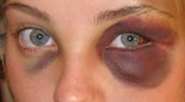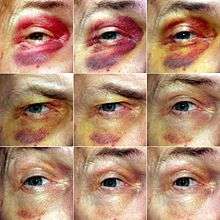Black eye
A black eye is bruising around the eye commonly due to an injury to the face rather than to the eye. The name is given due to the color of bruising. The so-called black eye is caused by bleeding beneath the skin and around the eye. Sometimes a black eye can worsen if not referred to a doctor if not resolved after a few months, indicating a more extensive injury - potentially even a skull fracture, particularly if the area around both eyes has bruised (raccoon eyes), or if there has been a prior head injury.
| Black eye | |
|---|---|
| Other names | Periorbital hematoma |
 | |
| Specialty | Emergency medicine |
Although most black eye injuries are not serious, bleeding within the eye, called a hyphema, is serious and can reduce vision and damage the cornea. In some cases, abnormally high pressure inside the eyeball (ocular hypertension) can also result.
Signs and symptoms

Despite the name, the eye itself is not affected. Blunt force or trauma to the eye socket results in burst capillaries and subsequent haemorrhaging (hematoma).[1] The fatty tissue along with the lack of muscle around the eye socket allows a potential space for blood accumulation. As this blood is reabsorbed, various pigments are released similar to a bruise lending itself to the extreme outward appearance.[1]
The appearance (discoloration purple black and blue and swelling) does not necessarily indicate a serious injury, and most black eyes resolve within a week. The tissues around the eye are soft and thus bruise easily when pinched against margins of bone which surround the eye socket. The treatment of black eye is the same as that for bruises in other parts of the body – cold compresses during the first twenty-four hours and contrasting hot and cold thereafter. During the process of healing, a black eye can be made less conspicuous by using cosmetics designed to obscure discolorations of the skin. In a severe contusion, blowout of the floor of the orbit may occur, leading to double vision. Such an injury requires surgical correction. A black eye developing after a severe head injury may be a sign of skull fracture.
Treatment
Unless there is actual trauma to the eye itself (see below), extensive medical attention is generally not needed.[1]
Applying an ice pack will keep down swelling and reduce internal bleeding by constricting the capillaries. Analgesic drugs (painkillers) can be administered to relieve pain.[1]
An anecdotal remedy for a black eye consists of applying raw meat to the eye area. Research has yet to find any evidence of this treatment being effective. Likely the raw meat was used when ice packs were not yet commercially available and meat was stored in iceboxes instead of in a protective gas, while cold but not but freezing meat is more gentle to the skin than ice, and will not damage the surface of the skin as the skin temperature cannot go below freezing even in extreme cases. Meat is also soft and comes easier into contact with the skin than blocks of ice that were available.
Associated conditions
Eye injury and head trauma may also coincide with a black eye. Some common signs of a more serious injury may include:
- Double vision
- Loss of sight and/or fuzzy vision could occur
- Loss of consciousness
- Inability to move the eye or large swelling around the eye
- Blood or clear fluid from the nose or the ears
- Blood on the surface of the eye itself or cuts on the eye itself
- Persistent headache or migraine
References
- "Black Eye". NHS Choices. NHS. 18 March 2011. Retrieved 27 October 2012.